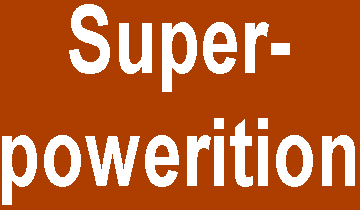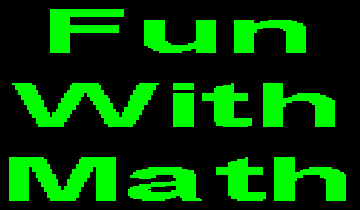 Home
DFS
SB
OD
SDN
Home
DFS
SB
OD
SDN
First off, there are differences on how you should be combining the numbers to create an answer for the four operators.
For instance, for the operation of Addition, let's say we have the numbers 2 and 3. We can represent the addition as 2 + 3 or 3 + 2. You can pick any two numbers and add them together in any order. You get the same answer. It's called the Communative Property of Addition. The Communative Rule is "a + b = b + a." Let's say you want to add the numbers 2, 3 and 4 together. You can have 2 + 3 + 4, 2 + 4 + 3, 3 + 4 + 2, 3 + 2 + 4, 4 + 2 + 3 and 4 + 3 + 2, which yields the answer of 9. You can do the same thing with negative numbers like 4 + -3 or -3 + 4, which yields the answer of 1.
The Associative Property of Addition says that the addition expression can be grouped in any way without affecting the sum. a + b + (c + d) is the same as a + (b + c) + d, (a + b + c) + d, (a + (b + c)) + d, and so forth. No matter where you place the parenthesis, you'll never change the value of the sum. You can switch them around to be (a + d) + b + c, (c + a + d) + b, and others you can think of on your own.
Note that Subtraction, the inverse operation of Addition, is not communative. 6 − 4 = 2, but 4 − 6 = -2. You can, however, turn subtraction into addition by adding the opposite of 4 like this: 6 + -4, which is 2, and you can switch those two numbers around like this: -4 + 6, which is 2. Subtraction is basically adding the opposite of one number indicated by the minus sign to a number, which might be either positive, negative, or zero.
The Communative Property of Multiplication is similar to that for Addition. You can change two or more numbers around without changing the product. 2 × 3 = 3 × 2, which yields 6. Likewise, you can do the same with three or more numbers like 2 × 3 × 4, which is the same as 3 × 4 × 2 and four other orders of those three numbers; the answer is still the same: 24. The Communative rule is "a × b = b × a."
The Associative Property of Multiplication says that the multiplication expression can be grouped in any way without affecting the product. a × b × (c × d) is the same as a × (b × c) × d, (a × b × c) × d, (a × (b × c)) × d, and so forth. No matter where you place the parenthesis, you'll never change the value of the product. You can switch them around to be (a × d) × b × c, (c × a × d) × b, and others you can think of on your own.
Note that Division, the inverse operation of Multiplication, is not communative. 4 ÷ 2 results in the number 2, but 2 ÷ 4 results in ½. To turn division into multiplication, you can turn the second number into the reciprocal of it, and for example 4 ÷ 2 is the same thing as 4 × ½ which in turn can be reversed to be ½ × 4, which gives the answer of 2.
With exponents, it's not quite the same thing as in addition and multiplication. For some pairings, they can be reversed, but for most, they cannot. For instance, 2⁴ = 2 × 2 × 2 × 2 = 16, and 4² = 4 × 4 = 16. This can work with certain pairs of numbers. For most of the time, such as 3² = 3 × 3 = 9, and 2³ = 2 × 2 × 2 = 8, exponentiation is not communative.
Exponentiation is not associative for the most part either. Let's say you have 222. You put parenthesis around the first two numbers like this: (22)2, then solve the first pair of numbers that need to be solved in the parenthesis like this: 42, then solve the rest of the exponentiation, which gives the answer of 16.
You put parenthesis around the second and third numbers like this: 2(22), then solve the first pair of numbers that need to be solved in the parenthesis like this: 24, then solve the rest of the exponentiation, which gives the answer of 16. In this case, it is associative.
Here's an example of exponentiation that is not associative as in many cases. Let's say you have 324. You put parenthesis around the first two numbers like this: (32)4, then solve the first pair of numbers that need to be solved in the parenthesis like this: 94, then solve the rest of the exponentiation, which gives the answer of 6,561.
You put parenthesis around the second and third numbers like this: 3(24), then solve the first pair of numbers that need to be solved in the parenthesis like this: 316, then solve the rest of the exponentiation, which gives the answer of 43,046,721. In this case, it is not associative. As a matter of fact, the right-to-left solving of the multi-exponential representation is associated with the Tetration operation, which we will cover soon, whereas the left-to-right solving of the multi-exponential representation is associated with Superpowerition.
When solving exponentiation problems such as a ^ b ^ c, or abc, you first solve a ^ b, then solve the resulting answer by ^ c like this in order as indicated by parentiesis: (a ^ b) ^ c. Take a to the power of b, then take the answer of it to the power of c. Do not go in the order of a ^ (b ^ c) unless indicated by parentiesis. Always solve from left to right or down to up. Do not go out of order unless indicated by parentiesis, which means you solve the numbers in the innermost parenthesis first, then solve them in the outer parenthesis until you're done.
Nth Rooting is the inverse operation of Exponentiation where you find the root (base in Exponentiation) using the known values for the radicand (power) and degree (exponent) Logarithm is the sideways operation of Exponentiation where you find the logarithm (exponent) using the known values for the base (base) and antilogarithm (power).
It is expected that Superpowerition is mostly not associative or communative, but there may be some exceptions that I have yet to find as it is a new operation.
© 1995-2024. davesfunstuff.com. All Rights Reserved. Reproduction of any part of this website without expressed written consent is prohibited.



